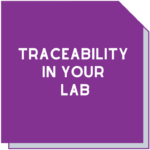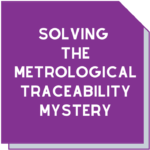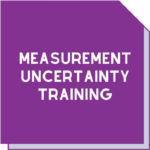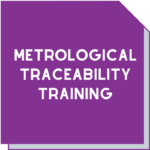Let’s talk about metrological traceability
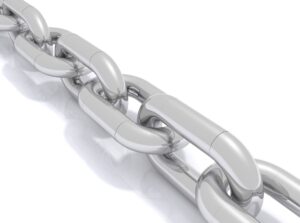
It’s entirely possible that metrological traceability won’t come up at your next social gathering. However, if you’re looking for a conversation starter in a lab, this is a sure-fire winner!
Anyone working in science and technology understands that there is often a need to compare results over time or between different batches or laboratories. Measurement traceability (MT) provides confidence that your results can be compared and linked back to national and international standards.
It also gives your customers that same confidence when they receive your reports. And that makes a big difference to their outcomes, particularly when you consider what they may be using that report for. From medical decisions to bridge building, the consequences of using incorrect results could be devastating.
For many labs, it is an essential element of their testing for their continued accreditation. It’s also an expensive part of the lab operations and sometimes auditors place requirements on the lab to spend even more money than may be actually needed. That creates pressure on the finances of the lab and perhaps the customer doesn’t even want that level of traceability. If this sounds like you, you should definitely read on!
What is metrological traceability?
We’ve written previously about unravelling the metrological traceability mystery. In that article, we explained what metrological traceability is:
In metrology (the science of measurement), traceability is widely defined as the ‘property of a measurement result whereby the result can be related to a reference through a documented unbroken chain of calibrations, each contributing to the measurement uncertainty’. You’ll see the same definition in NATA’s Metrological Traceability Policy document
Labs use reference equipment or standards to calibrate samples or items. This helps labs realise metrological traceability of their results. The reference equipment and standards are usually traceable to a national standard.
Your lab may not need traceability to SI units. In fact, depending on what you’re testing or calibrating, it may not be possible. However, you still need to demonstrate measurement traceability of your lab’s results. This helps to achieve appropriate comparability of results, depending on your client’s needs.
A quick word about measurement uncertainty
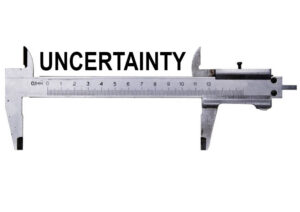 The estimates of measurement uncertainty (MU) published in your accreditation scope and your reports are directly affected by traceability.
The estimates of measurement uncertainty (MU) published in your accreditation scope and your reports are directly affected by traceability.
If you send your equipment out for calibration, the reports you receive when the equipment is returned will have estimates of MU associated with the results. This will be used in your uncertainty budgets for your results.
The shorter the chain between your lab and an NMI, the smaller the MU you’d expect to see. It’s important to ensure that the MU offered by a lab is suitable for your needs. But there are costs to having a shorter chain length between your lab and an NMI and hence a smaller MU. How do you know how long that chain should be?
By the way, if you have questions about MU in your lab, we have a training course that can help.
What does the standard say?
If your lab is accredited to ISO/IEC 17025 or looking to become accredited, you’ll need to be sure that your measurement system meets the requirements.
In a nutshell, the standard says that:
- If the equipment you’re using has a significant effect on your measurements results, it needs to be calibrated
- You need to have a programme and a procedure in place for equipment calibration
If you’re a calibration lab, wherever technically possible, you’ll need to establish an unbroken calibration chain, linking your measurement standards to a relevant primary standard of the SI unit.
If you’re a testing lab, you need to use a calibration service that is competent and capable of demonstrating that traceability. And you’ll also need to take a look at the traceability of any reference standards you’re using (they come up under the banner of ‘equipment’).
Perhaps you don’t believe that your lab equipment doesn’t affect your test. In this case, you need to have objective evidence to support your decision. And yes, an assessor will definitely want to see this!
Seeking traceability
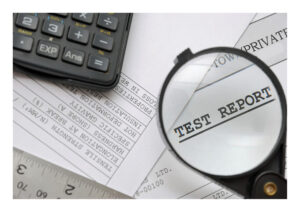 You have a few options when looking for MT from external services. You can use the services of an NMI, through an ISO/IEC 17025 accredited lab or through a certified reference material.
You have a few options when looking for MT from external services. You can use the services of an NMI, through an ISO/IEC 17025 accredited lab or through a certified reference material.
In Australia, the National Measurement Institute has a range of testing facilities.
For a list of accredited labs, the NATA website has a search function that can be used to find labs in your area.
Before you send your equipment to any lab, carefully review their scope of accreditation. Be sure they list the measurement function you’re seeking for your MT and that their calibration measurement capability meets your needs and that of any methods you are using in your lab.
If possible, seek quotes from more than one lab. Confirm that they can carry out the testing you need plus their turnaround time and pricing. Be sure you request an endorsed calibration certificate, bearing the symbol of the accreditation body, in line with their scope of accreditation.
As an accredited lab, they shouldn’t charge extra for a certificate bearing the symbol of the accreditation body. However this is also a useful question to ask.
When your equipment is returned, check the report! It must contain the accreditation body’s emblem, the results, an estimate of MU and a description of the reference standard.
For some areas of testing, like chemistry and biology, it’s not just about the equipment. Those expensive little vials of materials have to be the right ones for you to demonstrate appropriate MT. That’s where things can become tricky, and more expensive.
Traceability sounds easy, right?
Well it is. And it’s not…
Anyone who has been through an accreditation assessment can probably relay their own war stories about the thousands of dollars they have had to spend to satisfy the auditor. It need not be that way.
But when you book into our Without a trace – simple steps to measurement traceability course, we’ll make sure you’re on the right track!
We’ll show you how to demonstrate MT in your lab and give you the confidence you need to explain it at your next assessment.
Remember you don’t have to do this alone!
Download the article Lets talk about metrological traceability


